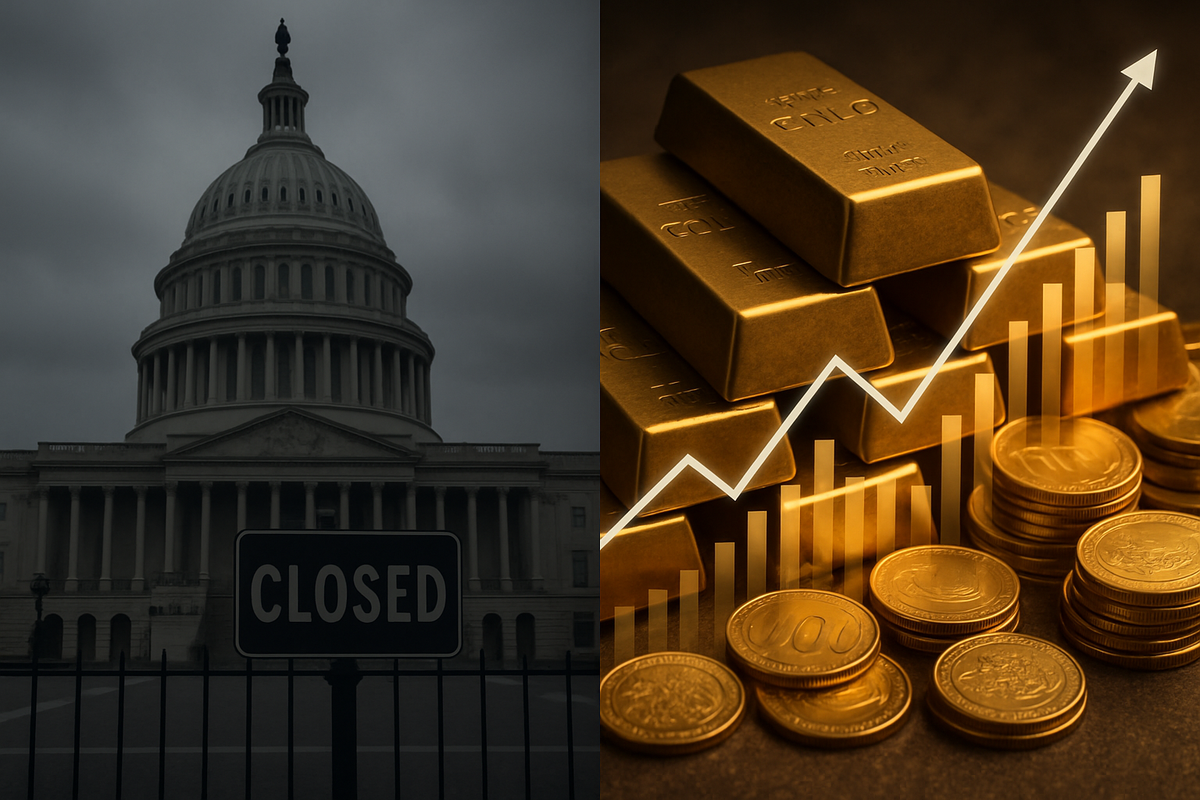
A prolonged U.S. government shutdown, now stretching into its twentieth day as of October 20, 2025, has sent ripples of anxiety across global financial markets, with gold emerging as a significant beneficiary. The precious metal, a traditional safe haven during times of political and economic instability, has seen a remarkable surge in value, reaching unprecedented highs. This robust performance underscores a heightened investor apprehension compared to previous shutdowns, signaling a deeper concern about economic stability and policy reliability in an already fragile global financial landscape. The impasse has not only idled hundreds of thousands of federal workers but has also cast a long shadow over the U.S. economy, driving investors to seek refuge in tangible assets.
Detailed Coverage
The current U.S. government shutdown, now in its third week and marking its twentieth day as of October 20, 2025, stems from a failure by Congress to pass the necessary 12 appropriations bills or a continuing resolution by the fiscal year 2026 deadline of September 30. This legislative impasse has resulted in the cessation of all non-essential government services, leading to the furlough of an estimated 750,000 to 900,000 federal employees, while another 700,000 are working without immediate compensation. Although a 2019 law guarantees back pay for furloughed federal workers upon resolution, federal contractors typically do not receive such compensation, exacerbating economic hardship for many.
The political deadlock is primarily centered in Washington, D.C., involving key players from both the legislative and executive branches. Congress, specifically the House of Representatives and the Senate, has been unable to reconcile partisan disagreements over federal spending levels, foreign aid rescissions, and health insurance subsidies. Competing proposals from Democratic and Republican factions have largely failed along party lines. President Donald Trump, a central figure in the executive branch, has been identified as a key player, with reports suggesting his administration has considered mass layoffs of federal employees in departments deemed low priority and has been accused of leveraging the shutdown to advance specific political agendas. Senate Minority Leader Chuck Schumer and House Democratic leader Hakeem Jeffries, along with their Republican counterparts, are at the forefront of ongoing negotiations, though public opinion polls indicate significant blame distributed among all parties involved.
Initial market reactions to this prolonged shutdown have been multifaceted, with gold exhibiting a particularly strong response. As the shutdown commenced, New York spot gold (XAU) surged, hitting a record $3,858.45 per troy ounce on October 1, 2025, with futures climbing towards $3,900. By October 16, 2025, gold prices had further escalated to a new record of $4,280.20 per troy ounce, a rally attributed not only to the government shutdown but also to underlying U.S.-China trade tensions and expectations of future Federal Reserve rate cuts. This robust performance solidifies gold's role as a primary safe-haven asset amidst escalating uncertainty.
In contrast, the broader stock market has shown a more mixed reaction. While historically, the S&P 500 (SPX) has shown modest and often temporary impacts during shutdowns, the current situation has introduced heightened volatility. The S&P 500 closed lower on October 15, 2025, reflecting concerns tied to the shutdown and trade jitters. However, some reports also noted instances where stocks closed at record highs despite the ongoing impasse, suggesting a degree of initial market resilience or an "unfazed" investor sentiment in certain sectors. Economically, each week of the shutdown is estimated to reduce annualized U.S. GDP growth by approximately 0.1 to 0.2 percentage points, with some economic output potentially being permanently lost. The delay in crucial government economic data further complicates the landscape for investors and policymakers, including the Federal Reserve, potentially hindering timely decisions on monetary policy.
Company Impact
The dual pressures of a prolonged U.S. government shutdown and a surging gold market create a landscape of distinct winners and losers among public companies and across various sectors. The shutdown directly impacts entities reliant on federal operations and spending, while the gold rally signals broader economic anxieties, benefiting specific segments.
Companies heavily integrated with government operations face significant headwinds. Government contractors, ranging from large defense firms to smaller IT service providers, are particularly vulnerable. While giants like Lockheed Martin (NYSE: LMT), Northrop Grumman (NYSE: NOC), and Raytheon Technologies (NYSE: RTX) may weather the storm better due to existing long-term contracts, they still face delayed payments and stalled approvals for new projects. Smaller firms, with tighter margins and fewer diversified revenue streams, could see substantial revenue loss and even layoffs. The travel and tourism industry is also taking a hit, with national parks and federally managed attractions either closed or operating with limited services. Airlines such as Delta Air Lines (NYSE: DAL) could experience reduced business travel from government employees, while staffing shortages among unpaid TSA workers and air traffic controllers could lead to flight delays and cancellations, impacting the broader travel ecosystem.
Small businesses across the nation are grappling with the cessation of critical federal services. The U.S. Small Business Administration (SBA) has halted the processing of new business loans, potentially delaying over $2 billion in funding over a 20-day period. Businesses located near federal offices or national parks are experiencing reduced foot traffic and revenue. Furthermore, delays in federal housing loan approvals (FHA, VA) and the halting of flood insurance policy issuance are directly impacting the real estate sector and mortgage lenders, creating bottlenecks in property transactions. Even certain aspects of financial services are affected, with IPOs potentially delayed as SEC officials review documents, creating backlogs for companies looking to go public.
Conversely, the dramatic ascent of gold prices, with futures trading above $4,200 per ounce, has created a bonanza for companies directly involved in the precious metal. Gold mining companies are experiencing significantly higher profit margins as their production costs remain relatively stable while the value of their output soars. Major producers like Newmont Corporation (NYSE: NEM) and Kinross Gold (NYSE: KGC) are poised for substantial boosts to their profitability and earnings. Similarly, gold streaming and royalty companies such as Wheaton Precious Metals Corp. (NYSE: WPM) and Franco-Nevada (NYSE: FNV) benefit immensely, as they provide upfront capital to miners in exchange for future production at fixed low prices or a percentage of revenue, essentially gaining from rising spot prices without operational mining risks. Exchange-Traded Funds (ETFs) like SPDR Gold Shares (NYSEARCA: GLD), which track the price of gold, also offer investors a direct way to capitalize on the rally.
However, the rising cost of gold poses challenges for industries that utilize the metal in their manufacturing processes. Companies in electronics, nanotechnology, and medical technology that rely on gold for components, circuit boards, or diagnostic tools will face increased raw material costs, potentially leading to higher production expenses or a push towards more cost-effective alternatives. Jewelry companies and retailers, including major players like Signet Jewelers (NYSE: SIG), are confronted with the dilemma of raising retail prices, which could deter consumer demand, or absorbing thinner profit margins. This could lead to a decrease in the affordability of precious metal jewelry and impact sales volumes, forcing strategic adjustments in their product offerings or pricing models.
Wider Significance
The convergence of a 20-day U.S. government shutdown and a surging gold market, as of October 20, 2025, carries profound wider significance, signaling a period of heightened uncertainty across economic, financial, and political landscapes. This prolonged legislative impasse, now nearing the record for the second-longest in U.S. history, amplifies its potential impact far beyond immediate disruptions, revealing deeper systemic concerns.
Economically, the shutdown continues to exert a substantial drag on growth. Each week of the impasse is estimated to reduce annualized GDP growth by 0.1% to 0.2%, with some projections reaching 0.25% as the duration lengthens, amounting to a weekly economic hit of $7 billion to $15 billion. This reduction stems from diminished government activity, delayed federal spending, and the direct impact of unpaid federal workers. Consumer and business confidence are eroding, with historical precedents, such as the 2018-2019 shutdown, showing a significant decline in consumer sentiment. A critical ripple effect is the delay in official economic data, including the U.S. jobs report and the Consumer Price Index (CPI). This "blind spot" leaves investors and policymakers, particularly the Federal Reserve, "operating a little bit blind," complicating their ability to make informed decisions regarding interest rates and monetary policy.
The regulatory and policy implications are equally significant. The political gridlock underscores deep legislative dysfunction, often rooted in fundamental disagreements over spending priorities. The current administration's contemplation of "large-scale reductions of Federal workers" signals a more aggressive approach to government restructuring, potentially altering federal capacity and services in the long term. Furthermore, the curtailed operations of numerous federal agencies, including the Securities and Exchange Commission (SEC), Federal Trade Commission (FTC), and Department of Justice (DOJ), can lead to regulatory delays and compliance challenges across various industries, affecting everything from export licensing to food and drug safety inspections. Internationally, global supply chains face disruptions as U.S. agencies responsible for regulatory reviews and customs clearances operate with reduced staff, slowing the pace of global commerce and potentially leading to commodity price swings and increased freight rates.
Historically, while government shutdowns have often had a limited lasting impact on overall equity performance, the current gold rally within a context of broader geopolitical and economic vulnerabilities suggests that investors are treating this shutdown as a significant, rather than fleeting, risk factor. Gold's surge to record highs, topping $4,300 per ounce, is a clear manifestation of its traditional role as a safe-haven asset. This rally is not solely attributable to the shutdown but is also fueled by persistent geopolitical tensions, expectations of U.S. interest rate cuts, a weaker U.S. dollar, and concerns about inflation and high global debt levels. The "de-dollarization trade," where global investors opt for hard assets over government bonds, also contributes to gold's appeal. Central banks globally have been significant buyers of gold, further reinforcing its institutional confidence and driving private investment flows into gold-backed Exchange-Traded Funds (ETFs). This dual development—a dysfunctional government and a soaring safe-haven asset—highlights a pervasive perception of instability in traditional financial and political structures, pushing capital towards non-sovereign, tangible assets.
What Comes Next
The confluence of a 20-day U.S. government shutdown and a robust gold rally sets the stage for a dynamic and uncertain future for financial markets. In the short term, the immediate aftermath of a prolonged shutdown will likely see continued volatility. Gold's role as a safe-haven asset is expected to remain reinforced, potentially sustaining its rally as long as the political impasse and economic uncertainty persist. However, investors should be prepared for potential profit-taking and temporary consolidation once a resolution appears imminent, as the immediate "crisis premium" on gold could diminish. The delay in crucial economic data, such as employment and inflation reports, will continue to complicate the Federal Reserve's decision-making regarding interest rates, potentially contributing to further market uncertainty and, consequently, continued support for gold.
Looking further ahead, the long-term possibilities suggest that gold prices could remain elevated, and potentially even reach new milestones. If underlying economic and geopolitical uncertainties—including ongoing trade tensions, fiscal strains, persistent inflation anxiety, and concerns about Federal Reserve independence—continue to linger, gold's appeal as a hedge and diversifier will likely lead to sustained high prices. Analysts from RBC Capital Markets have already lifted their price scenarios, with a middle case of $4,427 in 2026 and a high case ranging from $4,963 to $5,108 next year, suggesting a move beyond $5,000 per ounce is not unlikely. The ongoing trend of central banks diversifying their reserves away from the U.S. dollar and increasing gold holdings is a powerful long-term driver that a prolonged period of U.S. political instability could further reinforce.
For investors, strategic pivots will be crucial. Many may consider increasing their portfolio allocation to gold and other precious metals, with some asset managers discussing gold's share in portfolios in the 5-10% range, up from a traditional 5% cap. Diversification will be key, as gold's low correlation with equities and bonds during market stress makes it a valuable component of a well-balanced portfolio. Monitoring cues for a shutdown resolution will be paramount, as the "crisis premium" on gold can quickly evaporate, leading to selling pressure once political clarity emerges. Furthermore, equity exposure to select gold miners could present a strategic opportunity, as their cash flow might rise faster than gold prices in the short to medium term.
Market opportunities will primarily stem from gold's enduring safe-haven demand, its role as an inflation hedge, and a potentially weakening U.S. dollar environment. Continued central bank purchases and sustained inflows into gold-backed ETFs will also provide a robust demand foundation. However, challenges include gold's inherent volatility, the risk of a sharp correction upon shutdown resolution, and potential headwinds from an unexpectedly hawkish Federal Reserve or a strengthening U.S. dollar. Record high gold prices could also curb traditional consumer demand, particularly in price-sensitive markets, affecting overall market stability if investment demand falters. The current scenario of "compounding uncertainty" suggests that gold's role as a safe haven will likely keep its prices elevated, but investors must navigate the market with caution and agility.
Comprehensive Wrap-up
The 20-day U.S. government shutdown, now concluded as of October 20, 2025, served as a potent catalyst, alongside a confluence of global economic and geopolitical uncertainties, to propel gold into a historic rally. The precious metal’s surge to unprecedented highs, briefly touching $4,379.44 per ounce, unequivocally reaffirmed its role as the quintessential safe-haven asset in times of profound instability.
Key takeaways from this period underscore gold’s multifaceted drivers. While the government shutdown undeniably deepened economic uncertainty and delayed crucial data releases, the rally was also fueled by escalating global trade tensions, particularly between the U.S. and China, and ongoing conflicts. Furthermore, strong expectations for Federal Reserve interest rate cuts, persistent inflationary pressures, and a weakening U.S. dollar all contributed to gold’s enhanced appeal as a hedge against economic erosion. Notably, consistent gold purchases by central banks, especially in Asia and the Middle East, signaled a broader institutional pivot towards gold as a stable, independent store of value amidst global currency volatility and a desire to reduce dependence on the U.S. dollar.
Moving forward, the market assessment suggests a continued bullish outlook for gold. Many analysts view the recent rally not as a temporary speculative spike but as a "structural revaluation of gold's position in global finance." This perspective is supported by the ongoing fragility of the financial system, high global debt levels, and a perceived waning trust in major fiat currencies. Forecasts indicate gold could reach $4,500 per ounce in the near term and potentially $5,000 by 2026, assuming current instabilities persist. While a short-term correction of 10-15% is possible as gold may enter "overbought" territory, such a pullback would likely be considered a "healthy" consolidation before resuming its upward trajectory.
The lasting impact of this period is likely to be a reinforced perception of gold as a foundational asset for wealth preservation in an era characterized by unpredictable financial and geopolitical landscapes. The sustained demand from central banks and institutional investors, alongside individual buyers, points to a deeper, structural shift away from traditional reserve assets and toward gold as insurance against systemic disruptions and currency devaluation risks. Investors should closely monitor the trajectory of Federal Reserve monetary policy, particularly any further rate cuts or dovish signals, as these will significantly influence gold prices. Inflation trends, the strength of the U.S. dollar, and ongoing geopolitical developments will also be crucial indicators. The health of credit markets, specifically any signs of regional banking sector stress or broader credit quality deterioration, will continue to push investors toward safe assets. Finally, sustained central bank activity and robust inflows into gold-backed Exchange Traded Funds (ETFs) will signal continued institutional confidence and provide a strong price floor for gold. In essence, while the immediate "crisis premium" from the shutdown might dissipate upon its resolution, the broader economic and geopolitical environment suggests that gold’s upward trend, rooted in a fundamental re-evaluation of risk and value, is likely to endure well into 2026.
This content is intended for informational purposes only and is not financial advice





